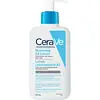What's inside
What's inside
 Key Ingredients
Key Ingredients

 Benefits
Benefits

 Concerns
Concerns

 Ingredients Side-by-side
Ingredients Side-by-side

Water
Skin ConditioningGlycerin
HumectantParaffinum Liquidum
EmollientIsopropyl Palmitate
EmollientPetrolatum
EmollientDimethicone
EmollientStearyl Alcohol
EmollientGlyceryl Stearate
EmollientPEG-100 Stearate
Panthenol
Skin ConditioningAllantoin
Skin ConditioningEthylhexylglycerin
Skin ConditioningPalmitic Acid
EmollientStearic Acid
CleansingAmmonium Acryloyldimethyltaurate/Vp Copolymer
Acrylates/C10-30 Alkyl Acrylate Crosspolymer
Emulsion StabilisingDisodium EDTA
Citric Acid
BufferingSodium Hydroxide
BufferingTocopherol
AntioxidantPhenoxyethanol
PreservativeParfum
MaskingWater, Glycerin, Paraffinum Liquidum, Isopropyl Palmitate, Petrolatum, Dimethicone, Stearyl Alcohol, Glyceryl Stearate, PEG-100 Stearate, Panthenol, Allantoin, Ethylhexylglycerin, Palmitic Acid, Stearic Acid, Ammonium Acryloyldimethyltaurate/Vp Copolymer, Acrylates/C10-30 Alkyl Acrylate Crosspolymer, Disodium EDTA, Citric Acid, Sodium Hydroxide, Tocopherol, Phenoxyethanol, Parfum
Salicylic Acid 3%
MaskingWater
Skin ConditioningGlycerin
HumectantParaffinum Liquidum
EmollientBehentrimonium Methosulfate
Cetearyl Alcohol
EmollientCetyl Alcohol
EmollientAmmonium Lactate
BufferingGlyceryl Stearate Se
EmulsifyingPEG-100 Stearate
Zea Mays Oil
EmulsifyingCholecalciferol
Dimethicone
EmollientCeramide NP
Skin ConditioningCeramide AP
Skin ConditioningCeramide EOP
Skin ConditioningCholesterol
EmollientPhytosphingosine
Skin ConditioningHyaluronic Acid
HumectantSodium Lauroyl Lactylate
EmulsifyingDisodium EDTA
Triethanolamine
BufferingMethylparaben
PreservativePropylparaben
PreservativeCarbomer
Emulsion StabilisingXanthan Gum
EmulsifyingSalicylic Acid 3%, Water, Glycerin, Paraffinum Liquidum, Behentrimonium Methosulfate, Cetearyl Alcohol, Cetyl Alcohol, Ammonium Lactate, Glyceryl Stearate Se, PEG-100 Stearate, Zea Mays Oil, Cholecalciferol, Dimethicone, Ceramide NP, Ceramide AP, Ceramide EOP, Cholesterol, Phytosphingosine, Hyaluronic Acid, Sodium Lauroyl Lactylate, Disodium EDTA, Triethanolamine, Methylparaben, Propylparaben, Carbomer, Xanthan Gum
Ingredients Explained
These ingredients are found in both products.
Ingredients higher up in an ingredient list are typically present in a larger amount.
Dimethicone is a type of synthetic silicone created from natural materials such as quartz.
What it does:
Dimethicone comes in different viscosities:
Depending on the viscosity, dimethicone has different properties.
Ingredients lists don't always show which type is used, so we recommend reaching out to the brand if you have questions about the viscosity.
This ingredient is unlikely to cause irritation because it does not get absorbed into skin. However, people with silicone allergies should be careful about using this ingredient.
Note: Dimethicone may contribute to pilling. This is because it is not oil or water soluble, so pilling may occur when layered with products. When mixed with heavy oils in a formula, the outcome is also quite greasy.
Learn more about DimethiconeDisodium EDTA plays a role in making products more stable by aiding other preservatives.
It is a chelating agent, meaning it neutralizes metal ions that may be found in a product.
Disodium EDTA is a salt of edetic acid and is found to be safe in cosmetic ingredients.
Learn more about Disodium EDTAGlycerin is already naturally found in your skin. It helps moisturize and protect your skin.
A study from 2016 found glycerin to be more effective as a humectant than AHAs and hyaluronic acid.
As a humectant, it helps the skin stay hydrated by pulling moisture to your skin. The low molecular weight of glycerin allows it to pull moisture into the deeper layers of your skin.
Hydrated skin improves your skin barrier; Your skin barrier helps protect against irritants and bacteria.
Glycerin has also been found to have antimicrobial and antiviral properties. Due to these properties, glycerin is often used in wound and burn treatments.
In cosmetics, glycerin is usually derived from plants such as soybean or palm. However, it can also be sourced from animals, such as tallow or animal fat.
This ingredient is organic, colorless, odorless, and non-toxic.
Glycerin is the name for this ingredient in American English. British English uses Glycerol/Glycerine.
Learn more about GlycerinParaffinum Liquidum is also known as liquid paraffin. It is a type of highly refined mineral oil.
Like other oils, Paraffinum Liquidum has emollient properties. Emollients help soothe and soften the skin. By creating a barrier to trap moisture within, emollients help keep your skin hydrated.
Paraffinum Liquidum does not irritate the skin and is non-comedogenic.
Learn more about Paraffinum LiquidumPeg-100 Stearate is an emollient and emulsifier. As an emollient, it helps keep skin soft by trapping moisture in. On the other hand, emulsifiers help prevent oil and water from separating in a product.
PEGS are a hydrophilic polyether compound . There are 100 ethylene oxide monomers in Peg-100 Stearate. Peg-100 Stearate is polyethylene glycol ester of stearic acid.
Water. It's the most common cosmetic ingredient of all. You'll usually see it at the top of ingredient lists, meaning that it makes up the largest part of the product.
So why is it so popular? Water most often acts as a solvent - this means that it helps dissolve other ingredients into the formulation.
You'll also recognize water as that liquid we all need to stay alive. If you see this, drink a glass of water. Stay hydrated!
Learn more about Water